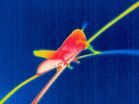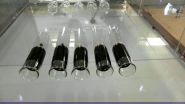(Press-News.org) Systems that automatically read automobile license plates have the potential to save police investigative time and increase safety, but law enforcement officials must address issues related to staffing, compatibility and privacy before the technology can reach its full potential, according to a new RAND Corporation report.
As part of efforts to promote innovation in law enforcement, many of the first generation license plate reader systems were purchased with federal and state grants. As these funding streams can be inconsistent, law enforcement agencies are – or will be – forced to make tough decisions about how to maintain the systems.
Making those decisions will require a clear understanding of the current and potential value of the systems to criminal justice agencies, according to RAND researchers.
"License plate readers are a relatively new technology that can be used to help investigate almost any type of crime," said Keith Gierlack, the study's lead author and a researcher at RAND, a nonprofit research organization. "But there are important issues, particularly about privacy, that must be addressed before this tool can reach its full potential."
Because the systems retain information about every license plate read, privacy advocates say law enforcement agencies could use license plate information to track movement of individuals, even if they are not suspects in a crime.
Key privacy issues facing local departments also include establishing standards about how long to keep information collected by license plate scanners, who in a department has access to the information and the types of investigations where the scanner information should be used, Gierlack said.
Some jurisdictions have adopted policies to retain data for set periods, such as six or 12 months. Legislation was introduced in California to regulate use of the license plate readers and legal decisions in New Hampshire, Maine and Virginia have restricted the technology. But no broadly accepted privacy guidelines have emerged to help guide police agencies that adopt the technology.
License plate readers are fixed or mobile cameras that capture an image of a passing vehicle, compare its license plate against official "hotlists" and alert authorities whether it may be of interest. Surveys have found that as many as 70 percent of local police agencies may be using the technology.
Promoted initially as a tool to assist in fighting auto thefts, the technology can be used in many additional ways that law enforcement agencies only have begun to discover.
Researchers say information collected by the scanners can be used to help track down many kinds of offenders (helping collect infraction fees), and could be used to help identify both crime hotspots and crime trends. In addition, the technology could help test the alibis of criminal suspects and support efforts to combat drug cartels and terrorist groups.
RAND researchers conducted their study by reviewing past research on the technology and conducting in-depth reviews of seven police departments that have adopted the technology. They examined budgeting, manpower and maintenance issues, as well as how the technology is being used to aid police work. Both large and small law enforcement agencies were studied, as well as agencies located along international borders.
RAND researchers found that license plate readers provide the most utility to police if they have access to multiple hotlists and other databases of license plates of interest, including DMV data. The lack of access to some of these hotlists reduces the types of investigations license plate readers can aid. Additionally, mechanisms for sharing license plate reader data between jurisdictions are not always available.
The study, "License Plate Readers for Law Enforcement: Opportunities and Obstacles," can be found at http://www.rand.org. Other authors of the study are Shara Williams, Tom LaTourrette, James M. Anderson, Lauren A. Mayer and Johanna Zmud.
Funding for the study was provided by the Office of Justice Programs at the
National Institute of Justice.
The project was conducted within the RAND Safety and Justice Program, which conducts public policy research on corrections, policing, public safety and occupational safety.
INFORMATION:
License plate readers are important police tool, but hurdles remain, study finds
2014-07-02
ELSE PRESS RELEASES FROM THIS DATE:
A 'magic moment' for unwed parents
2014-07-02
DURHAM, N.C. -- If unwed parents are going to get married, the best window of opportunity for that union seems to be before their child turns 3, says a new study from Duke University.
But patterns vary greatly by race, with more African-American mothers marrying much later than mothers of other races or ethnicities.
Federal policies have often presumed that unmarried parents will be most receptive to marriage right after a baby's birth, a period that has been dubbed the "magic moment." The new study is the first to test that assumption, said author Christina Gibson-Davis. ...
How do ants get around? Ultra-sensitive machines measure their every step…
2014-07-02
How do ants manage to move so nimbly whilst coordinating three pairs of legs and a behind that weighs up to 60% of their body mass? German scientists have recently developed a device that may reveal the answer.
Measuring the forces generated by single limbs is vital to understanding the energetics of animal locomotion. However, with very small animals such as insects, this becomes problematic. Dr Reinhardt (Friedrich-Schiller University) used an elastic polycarbonate material to produce a miniature force plate. Springs arranged at right angles to each other enabled forces ...
Locusts harness the sun to get their optimum diet
2014-07-02
If you are a locust, the most nutritious plant to eat depends on the ambient temperature. Scientists at the University of Sydney, Australia, have discovered that locusts choose their food and then where they digest it according to how hot it is.
Dr Fiona Clissold, who led the study, explains why temperature has such a large influence on insect diets. "Whilst an insect's metabolic rate increases exponentially with temperature, the rate at which locusts absorb protein and carbohydrate from different plants does not increase in step with temperature. As a result, nutrient ...
Smarter than you think: Fish can remember where they were fed 12 days later
2014-07-02
It is popularly believed that fish have a memory span of only 30 seconds. Canadian scientists, however, have demonstrated that this is far from true – in fact, fish can remember context and associations up to twelve days later.
The researchers studied African Cichlids (Labidochromis caeruleus), a popular aquarium species. These fish demonstrate many complex behaviours, including aggression, causing the scientists to predict that they could be capable of advanced memory tasks. Each fish was trained to enter a particular zone of the aquarium to receive a food reward, with ...
A sheep's early life experiences can shape behavior in later life
2014-07-02
New research has found that a sheep's experiences soon after birth can shape its later behaviour and also that of its offspring.
The study led by academics from the University of Bristol's School of Veterinary Sciences and published in the Royal Society journal Biology Letters investigated whether early-life experiences can alter behavioural responses to a naturally painful event in adulthood – giving birth – and also affect behaviour of the next generation.
The period following birth can be a challenging time for young lambs. They are usually tail-docked without analgesia ...
Patients with severe ME have little or no access to specialist treatment services
2014-07-02
One in three severely affected adults with ME in England have no access to local specialist services, new research has shown.
Published in the British Medical Journal Open, the research by the University of Southampton reveals NICE guidelines, which say severely affected patients with ME, otherwise known as chronic fatigue syndrome (CFS), should have access to specialist care, are not being met by many NHS Trusts across England.
Over a third of specialist adult ME/CFS services in the NHS provide no service to severely affected patients, and a further 12 per cent of ...
Nature of solids and liquids explored through new pitch drop experiment
2014-07-02
VIDEO:
The movie clip shows the bitumen flow from the top camera view, and corresponds to approximately 24 days of real time.
Click here for more information.
Physicists at Queen Mary University of London have set up a new pitch drop experiment for students to explore the difference between solid and liquids.
Known as the 'world's longest experiment', the set up at the University of Queensland was famous for taking ten years for a drop of pitch – a thick, black, sticky ...
New study involving CU-Boulder tells the tale of a kangaroo's tail
2014-07-02
VIDEO:
This video is an analysis of video of kangaroos walking has helped scientists discover how important their tails are during locomotion.
Click here for more information.
Kangaroos may be nature's best hoppers. But when they are grazing on all fours, which is most of the time, their tail becomes a powerful fifth leg, says a new study.
Involving researchers at the University of Colorado Boulder, Simon Fraser University in Burnaby, Canada, and the University of New ...
The Lancet: Nearly 80 percent of US deaths in the first three decades of life are due to unintentional injury or violence
2014-07-02
A new report on unintentional injury and violence in the United States, published in The Lancet as part of a new Series, The health of Americans [1], has found that prevention strategies across society show a great deal of promise in preventing unintended deaths and injuries.
According to the report, by CDC researchers from Atlanta, USA, more Americans between the ages of one and 30 die from injury than from any other cause. Every year, nearly 180 000 people in the USA die from preventable causes such as automobile crashes, drowning, firearm-related injuries, falls, ...
The Lancet: Infectious diseases cause significant burden in the USA
2014-07-02
Infectious diseases remain major public health challenges in the United States, according to a new report published in The Lancet as part of a new Series, The health of Americans [1]. Endemic conditions such as chronic viral hepatitis, human immunodeficiency virus, and other sexually transmitted infections continue to affect millions of individuals, with racial and ethnic minorities disproportionately affected. Emerging and re-emerging vector borne and zoonotic disease infections are threatening new areas and populations, as most recently observed with Chikungunya. Despite ...



